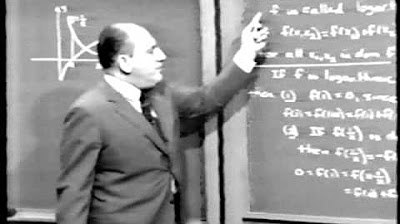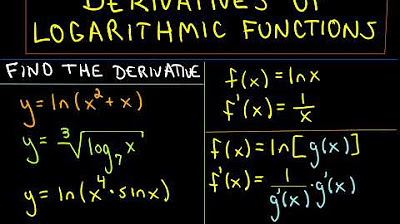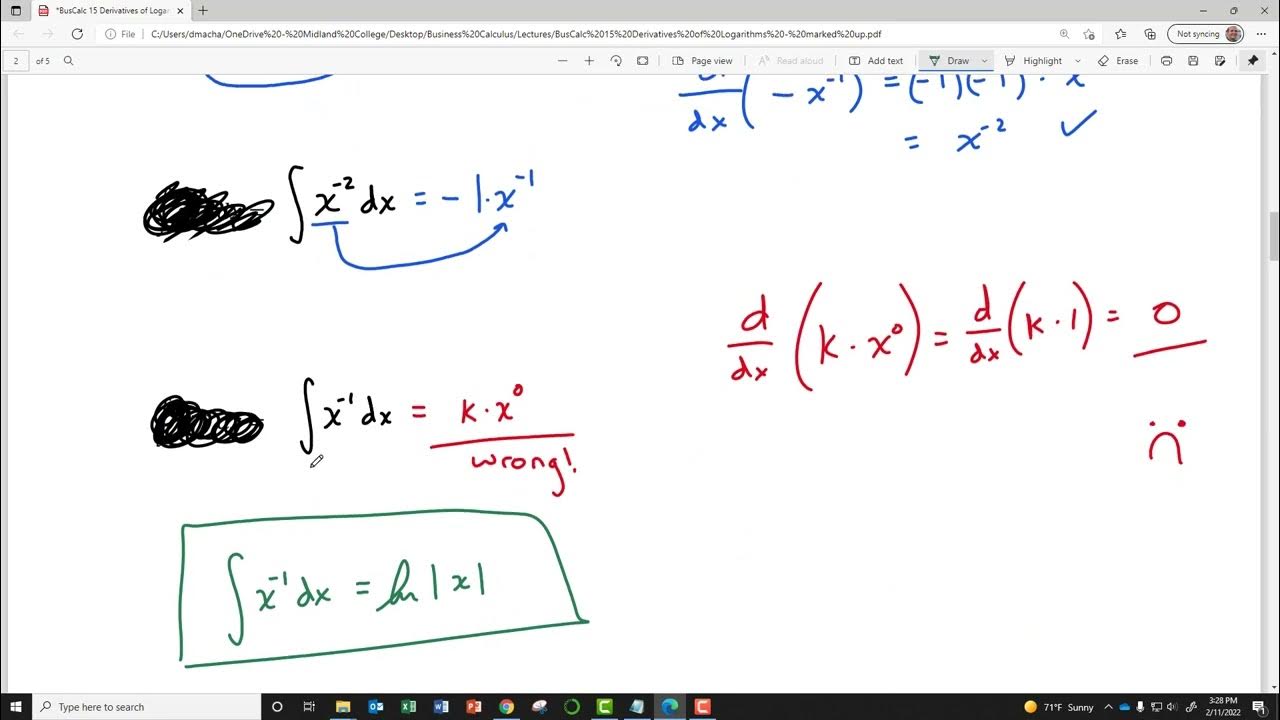Why don't they teach simple visual logarithms (and hyperbolic trig)?
TLDRThe video script explores the concept of anti-shapeshifters, which are shapes that remain invariant under squish-and-stretch transformations. It introduces the 1/x function as a prototype anti-shapeshifter and demonstrates its properties through visual transformations. The script then connects these shapes to logarithmic functions, specifically the natural logarithm, and explains how it can be derived from the area function of the 1/x shape. The video also touches on the relationship between logarithms and other mathematical concepts like hyperbolic functions and their applications in physics and engineering, providing a unique and visual approach to understanding these mathematical ideas.
Takeaways
- 📏 The concept of 'anti-shapeshifters' refers to shapes that maintain their area through squish-and-stretch transformations, such as the 1/x function.
- 🧠 The 1/x function is central to understanding logarithms, hyperbolic functions, and even the theory of relativity.
- 🔍 By visually manipulating shapes, it can be demonstrated that the area of the 1/x function remains constant under transformations, leading to the conclusion of its infinite area.
- ∞ The paradox of a shape having zero area while being contained within another shape with infinite area leads to the understanding that the 'blue spike' in the 1/x function has an infinite area.
- 📊 The infinite sum of the series 1 + 1/2 + 1/3 + ... equals infinity, which is an iconic truth in mathematics and can be visually proven without calculus.
- 📈 The area function A(x) under the curve of 1/x between 1 and x satisfies a product formula where A(x) + A(y) equals A(x*y), which is a characteristic property of logarithms.
- 🔢 The area function A(x) is identified as a logarithm due to its adherence to logarithmic properties such as product, quotient, and power formulas.
- 🌟 The base of the logarithm, which makes the area function equal to 1, is found to be the famous mathematical constant e (approximately 2.71828), leading to the identification of A(x) as the natural logarithm, ln(x).
- 📌 The process of squishing and stretching shapes reveals that scaled versions of the 1/x function are also anti-shapeshifters, corresponding to different logarithms with various bases.
- 🔄 The visual similarities between the graph of 1/x and a circle rotating inspired the development of hyperbolic trigonometric functions, such as hyperbolic sine (SHINE) and cosine (cosh).
- 🌐 Hyperbolic functions have practical applications in physics and engineering, including describing the shape of hanging chains and the mathematical framework for Lorentz transformations in special relativity.
Q & A
What is the main concept discussed in the video?
-The main concept discussed in the video is the idea of 'anti-shapeshifters', specifically focusing on the function 1/x and how it relates to logarithms, hyperbolic functions, and their applications in mathematics and physics.
How does the video demonstrate that the area of a shape remains constant during squish-and-stretch transformations?
-The video demonstrates this by showing that when a shape is squished by a factor, its area is reduced to half, and then when it is stretched by the same factor, the area is doubled back to the original size, thus maintaining the same area throughout the transformation.
What is the significance of the number e in the context of the video?
-In the context of the video, e (approximately 2.71828) is the base of the natural logarithm, which is derived from the area function of the 1/x anti-shapeshifter. It is a fundamental mathematical constant with extensive applications in various fields.
How does the video connect the 1/x function to logarithms and hyperbolic functions?
-The video connects the 1/x function to logarithms by showing that the area under the 1/x curve corresponds to the natural logarithm function. It then extends this idea to hyperbolic functions by demonstrating how the 1/x function can be transformed into hyperbolic sine and cosine functions through scaling and geometric transformations.
What is the product formula for logarithms mentioned in the video?
-The product formula for logarithms mentioned in the video is log_b(x) + log_b(y) = log_b(x * y). This formula is visually demonstrated in the video by showing that the sum of areas under the logarithmic curve for x and y equals the area for their product x*y.
How does the video explain the concept of infinite area in a shape?
-The video explains the concept of infinite area by using the 1/x function and showing that the area under the curve can be considered infinite because it approaches infinity as x approaches zero and infinity.
What is the significance of the function A(x) in the video?
-The function A(x) is used in the video to represent the area under the 1/x curve up to the point x. It is used to visually demonstrate the properties of logarithms and to derive the natural logarithm function.
How does the video use the concept of squish-and-stretch to introduce hyperbolic functions?
-The video uses the concept of squish-and-stretch to show how the 1/x function can be transformed into hyperbolic functions. By squishing the 1/x function towards the origin and then stretching it horizontally, the video demonstrates how this transformation leads to the hyperbolic sine and cosine functions.
What is the relationship between the natural logarithm and the area function discussed in the video?
-The area function discussed in the video, which corresponds to the area under the 1/x curve, is identified as the natural logarithm function. The video demonstrates this by showing that the properties of the area function, such as the product, quotient, and power rules, match those of logarithmic functions, leading to the conclusion that the area function is indeed the natural logarithm.
What is the significance of the hyperbolic functions derived in the video?
-The hyperbolic functions derived in the video, such as hyperbolic sine (sinh) and cosine (cosh), are significant because they have numerous applications in physics and engineering. For example, they describe the shape of hanging chains and cables and are used in the theory of special relativity through Lorentz transformations.
How does the video connect the concept of area of a sector to angles in trigonometry and hyperbolic geometry?
-The video connects the concept of area of a sector to angles by showing that the area of a sector in a circle (for trigonometry) can be related to the area of a hyperbolic sector. This connection is used to derive hyperbolic sine and cosine functions from their trigonometric counterparts, essentially by scaling the circle and transitioning to a hyperbola.
Outlines
🧩 Introduction to Anti-Shapeshifters
This paragraph introduces the concept of anti-shapeshifters, which are shapes that remain the same size and area after undergoing a squish-and-stretch transformation. The video begins with a simple example of a square being transformed into a rectangle and then back into a square, maintaining the same area. The speaker then poses a question about the existence of a shape that is immune to these transformations, hinting at the existence of such shapes and their connection to complex mathematical concepts like logarithms, hyperbolic functions, and the theory of relativity.
🌟 The Iconic Infinite Staircase
In this paragraph, the speaker delves into the iconic infinite staircase, a visual representation of the infinite sum of the series 1 + 1/2 + 1/3 and so on. The staircase is constructed using the concept of 1/x and its relation to the areas of the steps. The speaker demonstrates that the area of the staircase is both infinite and equal to the sum of the areas of the individual steps, leading to the conclusion that the infinite sum equals infinity. This proof is highlighted as an example of a neat mathematical argument that does not require calculus.
🔄 The Magic of Shapeshifter Algebra
This section explores the algebraic properties of the shapeshifter, specifically the 1/x function, and how it behaves under squish-and-stretch transformations. The speaker introduces the concept of area function A(x) and demonstrates that A(2) plus A(3) equals A(6), showing that sums can be transformed into products. This leads to the general rule A(x) + A(y) = A(x * y). The speaker also discusses the product, quotient, and power formulas for logarithms and suggests that the area function may be a logarithm in disguise.
🏹 Identifying the Mysterious Base
The speaker continues the exploration of the area function, which is hypothesized to be a logarithm. The goal is to identify the base of this logarithmic function. By examining special values, such as A(1) = 0, and the behavior of the function as x approaches infinity, the speaker narrows down the search for a special value of x that yields an area of 1. Through a series of visual arguments and approximations, the speaker arrives at the number e (approximately 2.71828) as the base of the natural logarithm.
🌐 The Scaled Shapes and Their Logarithmic Connections
In this paragraph, the speaker discusses the connection between the scaled shapes obtained from the 1/x anti-shapeshifter and different logarithms. By squishing the original shape by a factor of 2, a new area function is created, which is 1/2 times the natural logarithm. The base of this new logarithm is found by solving for the value of x that makes the function equal to 1. This process can be repeated for other scaled shapes, leading to a family of logarithmic functions with different bases. The paragraph emphasizes the visual and algebraic properties of these anti-shapeshifters and their relation to logarithms.
🌀 Hyperbolic Functions and the Geometry of Angles
The speaker concludes the video by connecting the concepts of anti-shapeshifters to hyperbolic functions and their relation to trigonometric functions. By examining the area of sectors in a hyperbola, the speaker introduces hyperbolic sine and cosine functions, or cosh and shine. The properties of these functions are explored, including their relation to the exponential function and Euler's formula. The video ends with a discussion of the importance of hyperbolic functions in physics and engineering, and the speaker invites viewers to engage with the content through comments and further exploration.
Mindmap
Keywords
💡Anti-shapeshifters
💡Squish-and-stretch transformations
💡Logarithms
💡Hyperbolic functions
💡Infinite area
💡Natural logarithm
💡Number e
💡Visual heart
💡Trigonometric functions
💡Lorentz transformations
Highlights
The concept of anti-shapeshifters and their immunity to squish-and-stretch transformations.
The intriguing question of the existence of shapes that remain unchanged before and after a transformation.
The mathematical demonstration that shapes with non-zero area can be anti-shapeshifters.
The connection between anti-shapeshifters and fundamental mathematical concepts like logarithms and hyperbolic functions.
The visual representation of 1/x as an anti-shapeshifter and its surprising appearance in a Rubik's cube.
The algebraic proof that the shape and area of 1/x remain unchanged under squish-and-stretch transformations.
The paradoxical conclusion that the area of the 1/x shape is both infinite and contained within a finite shape.
The iconic mathematical truth that the infinite sum 1 + 1/2 + 1/3 and so on equals infinity, demonstrated through a clever geometric argument.
The introduction of the area function A(x) and its surprising properties that mirror logarithmic functions.
The discovery that the area function A(x) is, in fact, a logarithm through a series of visual experiments.
The identification of the base of the logarithm as the famous mathematical constant e.
The explanation of how other logarithms can be derived from scaled versions of the 1/x anti-shapeshifter.
The transition from circular trigonometric functions to their hyperbolic counterparts through a geometric analogy.
The derivation of hyperbolic functions and their properties using the concept of area instead of arc length.
The demonstration of how hyperbolic functions relate to the exponential function and Euler's formula.
The practical applications of hyperbolic functions in physics and engineering, such as describing the shape of hanging chains.
The connection between hyperbolic rotations and Lorentz transformations in the theory of special relativity.
The encouragement for viewers to engage with the material by asking questions and offering their own insights in the comments.
Transcripts
Browse More Related Video

2.3 - Derivatives of Logarithmic Functions

Graphs You Must Know (Precalculus - College Algebra 13)

Unit V: Lec 1 | MIT Calculus Revisited: Single Variable Calculus

Introduction to Logarithms and Their Graphs (Precalculus - College Algebra 55)

Derivatives of Logarithmic Functions - More Examples

BusCalc 15 Derivatives of Logarithms
5.0 / 5 (0 votes)
Thanks for rating: